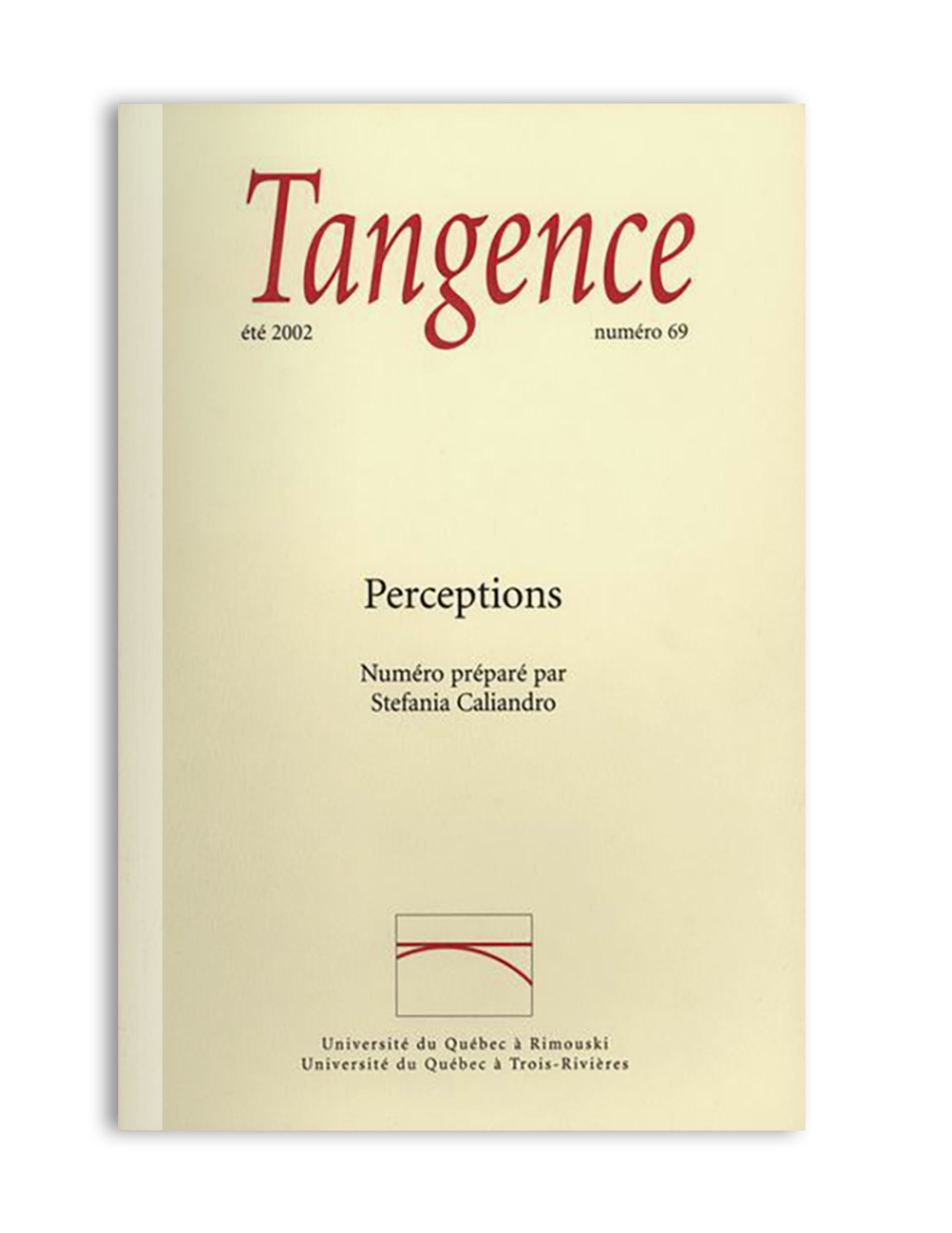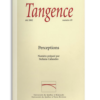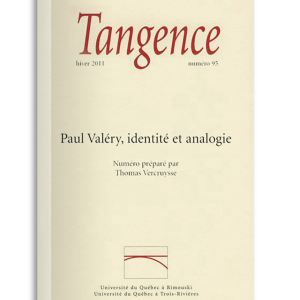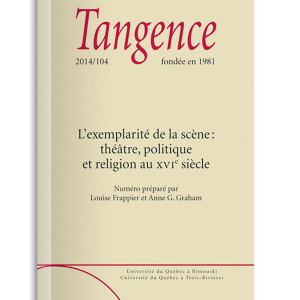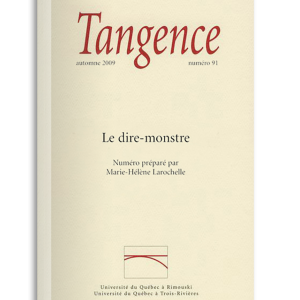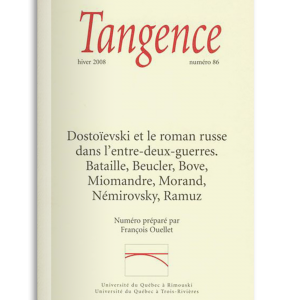N° 69, été 2002
Perceptions
Pierre Ouellet
Une esthétique de l’énonciation. La communauté des singularités
Nous postulons que les discours esthétiques sont porteurs de nouveaux modèles de socialité par le type d’ethos énonciatif qu’ils mettent en place, c’est-à-dire par les « manières d’être ou de vivre » dans le langage (et dans le monde dont il parle) qu’induisent les formes intersubjectives d’énonciation propres aux actes de paroles qu’ils incarnent. Pensant par affects et par percepts, plutôt que par idées, valeurs ou concepts, la littérature et l’art renvoient à une socialité du monde sensible ou à des configurations collectives de la sensibilité (des les « esthésies »), qui passent notamment par la fonction conative du langage, responsable pour une large part de la dimension empathique de l’expérience esthétique. Le présent article cherche à saisir la nature et la dynamique des modes de co-existence politique, au sein de la Cité ou de l’Agora (de l’espace public de la parole), qu’entraînent les pratiques non communicationnelles du langage, pour mettre en lumière les aspects non sémantiques mais « esthésiques » au sens fort (du grec aisthesis : perception par les sens externes et internes) qui sous-tendent les mécanismes de socialisation et de subjectivation dans lesquels singularité et communauté ne s’opposent plus mais s’entrelacent en un véritable chiasme.
An Aesthetics of Enunciation : the Community of Singularities
We postulate that aesthetic discourses bring new models of sociality through the type of enunciative ethos they put into place, that is, through the « ways of being or of living » in language (and in the world it speaks of) induced by the intersubjective forms of enunciation characteristic of the acts of words they embody. By thinking through emotions and perceptions, rather than through ideas, values or concepts, literature and art refer to a sociality of the sensitive world or to collective configurations of sensitivity (« esthesias »), which pass, notably, through the conative function of language, which is largely responsible for the empathic aspect of aesthetic experience. This article seeks to grasp the nature and dynamic of the modes of political co-existence within the Cité or the Agora (the arena for public speaking) that the non-communicational practices of language lead to, in order to highlight aspects that are non-semantic, but « esthesic » in the strict sense of the word (from the Greek aisthesis, meaning perception by external and internal senses), and which underlie the mechanisms of socialization and of subjectivation in which singularity and community no longer oppose one another but interconnect, rather, in a veritable chiasmus.
***
Clélia Nau
L’aperception des ressemblances. Métaphores filées dans l’Apollon amoureux de Daphné de Poussin
Cet article entend montrer l’intérêt pour une pratique — celle de Poussin en particulier — aussi bien que pour une théorie de la peinture de la transposition dans l’ordre du visuel d’une figure — la métaphore — qu’on pouvait croire exclusivement liée à l’exercice de la langue encore qu’Aristote lui reconnût le pouvoir de « faire tableau ». À travers et au-delà même du cas de Poussin qui, bien souvent, au lieu d’une histoire unique, représente une véritable constellation de mythes liés entre eux par tout un réseau d’analogies — ainsi en va-t-il dans le tableau intitulé Apollon amoureux de Daphné qui sera ici décrit en détail —, il convient de s’interroger sur les conséquences, pour le travail du peintre comme pour celui de l’interprète, de cet usage de la métaphore en peinture. Si cette figure suppose, ainsi que l’écrit Aristote dans la Poétique, la perception théorique de la ressemblance et si le peintre y a recours dans l’élaboration de ses sujets, qu’en est-il dès lors du phénomène de l’invention en peinture ? Comment l’interprète procédera-t-il dans sa lecture du tableau si tout y est subordonné au jeu de la métaphore, si seule la restitution des ressemblances aperçues par le peintre permet de donner sens à l’agencement des figures sur la toile ? L’ambition de ces pages est moins de proposer une méthode d’interprétation des tableaux de Poussin que de mettre l’accent sur les difficultés rencontrées dès lors qu’on s’engage pleinement, sans faire l’économie des détours qu’elle impose, dans l’herméneutique complexe de ces images insolites.
The Apperception of Resemblances. Extended Metaphors in Poussin’s Apollon amoureux de Daphné
The aim of this article is to demonstrate the interest in a practice (that of Poussin in particular) as well as a theory of painting the transposition in the visual order of a figure (the metaphor) which may be thought linked exclusively to the exercise of language, whereas Aristotle recognized it as the power of « painting a picture. » By focusing on Poussin, who, rather than depict a single story, very often represented a veritable constellation of myths interconnected by a network of analogies (as in the case of Apollon amoureux de Daphné, which will be described here in detail), we must ask what the consequences are, for both the painter and the interpreter, of this use of metaphor in painting. If, as Aristotle wrote in his Poetics, this figure supposes the theoretical perception of likeness, and if the painter has recourse to it when elaborating his subjects, then what, one may ask, is the role of invention in painting ? How will the interpreter read the painting if everything is subordinated to the game of metaphor, if only the reconstruction of likenesses perceived by the painter makes it possible to give meaning to the arrangement of figures on the canvas ? This article does not propose a method for interpreting Poussin’s paintings ; it aims, rather, to underscore the difficulties encountered when one is fully engaged — which includes accepting all detours that may be imposed — in the complex hermeneutics of these unusual images.
***
Boris Eizykman
Deux cafés, Steinberg et son complexe
Si les images appartiennent au domaine des « complications simultanées sur plusieurs dimensions » (Saussure) et si leur inépuisable polysémie procède essentiellement d’un tel pouvoir de simultanéité, une analyse respectueuse de son objet visuel doit s’efforcer, quand bien même elle utilise la linéarité propre au langage, d’en retrouver la complexité singulière. Pour ce faire, elle étudiera patiemment l’interaction des constituants de chaque image, elle s’attachera à la moindre inflexion, à la plus petite nuance formelle susceptible de modifier la composition d’ensemble, et, avec elle, le sens des intentions auxquelles, dans un contexte historique donné, un artiste a voulu donner vie par le choix et l’agencement de ses matériaux et de ses rythmes. L’article tente de mener à bien cette opération délicate en montrant que Saul Steinberg (1914-2000), dans deux dessins de café réalisés en 1955 et aux alentours de 1970, condense, grâce à la simultanéité fondamentale de l’image, critique politique d’un monde qui s’altère et critique du monde qui participe à l’altération générale.
Two cafés, Steinberg and His Complex
If images belong to the domain of « simultaneous complications on several dimensions » (Saussure), and if their inexhaustible polysemy proceeds essentially from such power of simultaneity, any analysis respectful of its visual object must strive — even through the linearity characteristic of language — to discover the object’s singular complexity. To accomplish this, the analysis must examine patiently how each element of the image interacts with the others ; it must pinpoint the slightest inflection, the subtlest formal nuance that liable to modify the composition as a whole, and with it the meaning of the intentions a particular artist wished to bring to life through the choice and arrangement of his materials and rhythms, within a given historical context. This article attempts to perform this difficult task by showing that in two drawings of cafés done in 1955 and circa 1970, Saul Steinberg (1914-2000) — thanks to the fundamental simultaneity of the image — condenses a political critique of a world in the process of being altered and that of those who participated in its general alteration.
***
Anne Beyaert
Une sémiotique du portrait
Genre le plus prolifique de la peinture, le portrait en est également l’origine puisque, selon un mythe remontant à Pline l’Ancien, c’est l’ombre portée d’un corps et sa délinéation qui déclencha l’invention des arts visuels. Or, là où l’histoire de l’art convient plutôt de la diversité du genre et rappelle que, de L’homme du puits du Paléothique jusqu’aux plus récents tableaux de Glenn Brown, le portrait n’omet aucune époque ni aucun style, la sémiotique peut, en s’attachant à un « modèle énonciatif », ambitionner d’établir son unité.
Tout d’abord, si le souci du portrait se partage historiquement entre la ressemblance et l’expressivité, la visée mimétique qu’il accomplit se conçoit plus fondamentalement comme un « effet de présence ». Il s’agit de faire « comme si l’autre, l’absent était ici et maintenant le même, non pas présence mais effet de présence », estime Louis Marin, qui reprend ainsi les termes du traité d’Alberti et assigne à la peinture la vocation de « rendre les absents présents ». À quoi tient alors le souffle de vie ? À certaines dispositions de la syntaxe figurative, à l’inscription particulière de la figure dans la profondeur de l’espace pictural, des données qui s’accordent pour constituer la présence sémiotique de l’absent. En s’attachant à porter le poids de présence sur le corps représenté, le dispositif du portrait convoque également la notion de rivalité actantielle et détermine la relation de la figure au fond.
On parvient ainsi à une définition sémiotique du portrait fondée sur trois instances, le visage, la tête puis le regard, qui restituent les conditions de la présence de l’autre. Car dans son effort pour incarner la figure actorielle et donner ce souffle de vie qui « rend présent » l’absent, le portrait restitue surtout une expérience affective par laquelle deux sujets se « destinent » l’un à l’autre.
A Semiotics of Portraiture
The most prolific of all genres of painting, portraiture is also the origin of painting, since, according to a myth dating back to Pliny the Elder, the shadow of a body and its delineation was what triggered the invention of the visual arts. Now, where art history agrees rather on the diversity of the genre and recalls that, from the Paleolithic Dead Man in Lascaux up to the latest paintings by Glenn Brown, portraiture encompassess all periods and styles, semiotics can, by adopting an « enunciative model », attempt to establish its unity.
First of all, if the main concern of portraiture has historically been divided between resemblance and expressiveness, the mimetic aim it achieves is basically conceived as the « effect of presence. » The purpose is to act « as if the other, the absent one, were here and now the same, not a presence but an effect of presence, » maintains Louis Marin, who in so saying takes the terms of Alberti’s treatise and assigns to painting the vocation of « making the absent present. » Then to what do we owe the breath of life ? To certain arrangements of figurative syntax, to the particular representation of the figure in the depth of the pictural space, of the data that come together to make up the semiotic presence of the absent one. By endeavoring to make the body represented bear the burden of presence, the portrait design also summons the notion of actantial rivalry and determines the relationship of the figure to the background.
We arrive then at a semiotic definition of portraiture that is based on three essential points — the face, the head and the gaze, all of which reproduce the conditions for the presence of the other. For in its effort to incarnate the actorial figure and give it the breath of life that « makes present » one who is absent, the portrait reproduces above all an emotional experience by which two subjects « become destined » to each other.
***
Jean-Claude Chirollet L’approche de l’art d’un point de vue fractaliste
La science des « objets fractals », objets mathématiques spécifiques de la géométrie non euclidienne inventée par le mathématicien Benoît Mandelbrot dès les années 1960, a été mise à l’honneur de la littérature scientifique en 1975 dans son livre fondamental, Les objets fractals. Forme, hasard et dimension. Cette géométrie qui s’applique aux formes irrégulières de la nature complexe autant qu’aux figures de la mathématique pure, a servi de base de réflexion et de création aux artistes du mouvement fractaliste international des années 1980 à aujourd’hui, quel que soit le domaine particulier de leurs investigations artistiques respectives (arts plastiques, arts numériques, photographie, musique, voire littérature).
À partir de ces réflexions et théories complémentaires, à la fois mathématiques et artistiques, il semble possible de développer une approche compréhensive généralisée des créations artistiques qui soit en accord avec elles, bien au-delà du seul art fractaliste. Autrement dit, nous nous interrogeons ici sur les principes fondamentaux d’une théorisation esthétique fractaliste concernant les réalités artistiques en général et plus particulièrement en arts plastiques, prenant appui sur les méthodes et les modèles pris en compte et appliqués en art et en science du fractal. Dans cette perspective, nous verrons que c’est non seulement le problème de la modélisation théorique de l’œuvre d’art qui est en jeu, mais tout autant celui de l’être cognitif du sujet percevant.
Approaching Art from a Fractalist Point of View
The science of « fractal objects, » specific mathematical objects from the non-Euclidean geometry invented by mathematician Benoît Mandelbrot in the 1960s, was introduced into the scientific literature in 1975 in Mandelbrot’s seminal work, Les objets fractals. Forme, hasard et dimension. This geometry, which applies to complex and irregular forms in nature as well as to figures from pure mathematics, served as a basis of reflection and creation for artists of the international fractalist movement — regardless of their respective artistic fields (plastic arts, digital art, photography, music, even literature) — in the period from 1980 to 2002.
Using these complementary reflections and theories, at once mathematical and artistic, it appears possible to develop a generalized and comprehensive approach to artistic creation that is in harmony with it and is not limited to fractalist art alone. In other words, we will examine the fundamental principles of fractalist, aesthetic theorization regarding artistic realities in general — particularly in the plastic arts — which rest on methods and models taken into account and applied in art and in the science of fractal. Viewed from this perspective, we can see that the issue here is not only the problem of the theoretic modelization of the work of art, but the problem of the cognitive being of the perceiving subject as well.
***
Stefania Caliandro
L’émergence d’une psychophysique de la perception en art
Des considérations psychophysiques interviennent dans l’appréhension d’ une œuvre d’art. L’évolution d’une conception psychophysique, dont l’émergence date au moins de la fin du XIXe siècle, a d’ailleurs joué sur l’éclosion de l’abstraction. Après avoir brièvement reparcouru les racines de l’art abstrait en tant que mouvement historique, l’étude envisage les avancées qui se produisaient à cette époque dans la réflexion sur la perception : les apports des théories de l’empathie et de la psychophysique qui influençaient autant les artistes que les théoriciens de l’art et de la vision.
L’analyse d’un tableau de Wassily Kandinsky, Moscou I (place rouge) de 1916, donne enfin à voir quelques enjeux esthétiques et sémiotiques de la perception. À la limite ou en-deçà du seuil d’iconicité, ce tableau laisse en fait saisir comment l’abstraction, plus qu’un dépassement tout court de la figuration, travaille une conception organique du champ perceptif. Tout en l’insérant dans le contexte contemporain et dans les réflexions et l’œuvre de cet artiste, l’approfondissement de ses dynamiques et effets perceptifs témoigne de leur participation profonde au sens du tableau.
The emergence of a psychophysics of perception in art
Psychophysical considerations enter into the understanding of a work of art. The evolution of a concept of psychophysics, which dates to the end of the 19th century at least, has moreover played a role in the flowering of the abstract movement. After a brief survey of the roots of abstract art as an historic movement, this study will focus on advances made at the time concerning thinking on perception — the contributions of theories of empathy and psychophysics which influenced both artists and theorists of art and vision.
The analysis of a painting by Wassily Kandinsky, Moscou I (place rouge) from 1916, highlights some aesthetic and semiotic issues concerning perception. Bordering on iconicity, this painting makes it possible to grasp how abstraction, more than simply transcending protrayal, formed an organic concept of the field of perception. This concept was integrated into the thought, work and historical context of this artist, and the intensification of his dynamics and perceptive effects bears witness to their profound contribution to the meaning of the painting.

